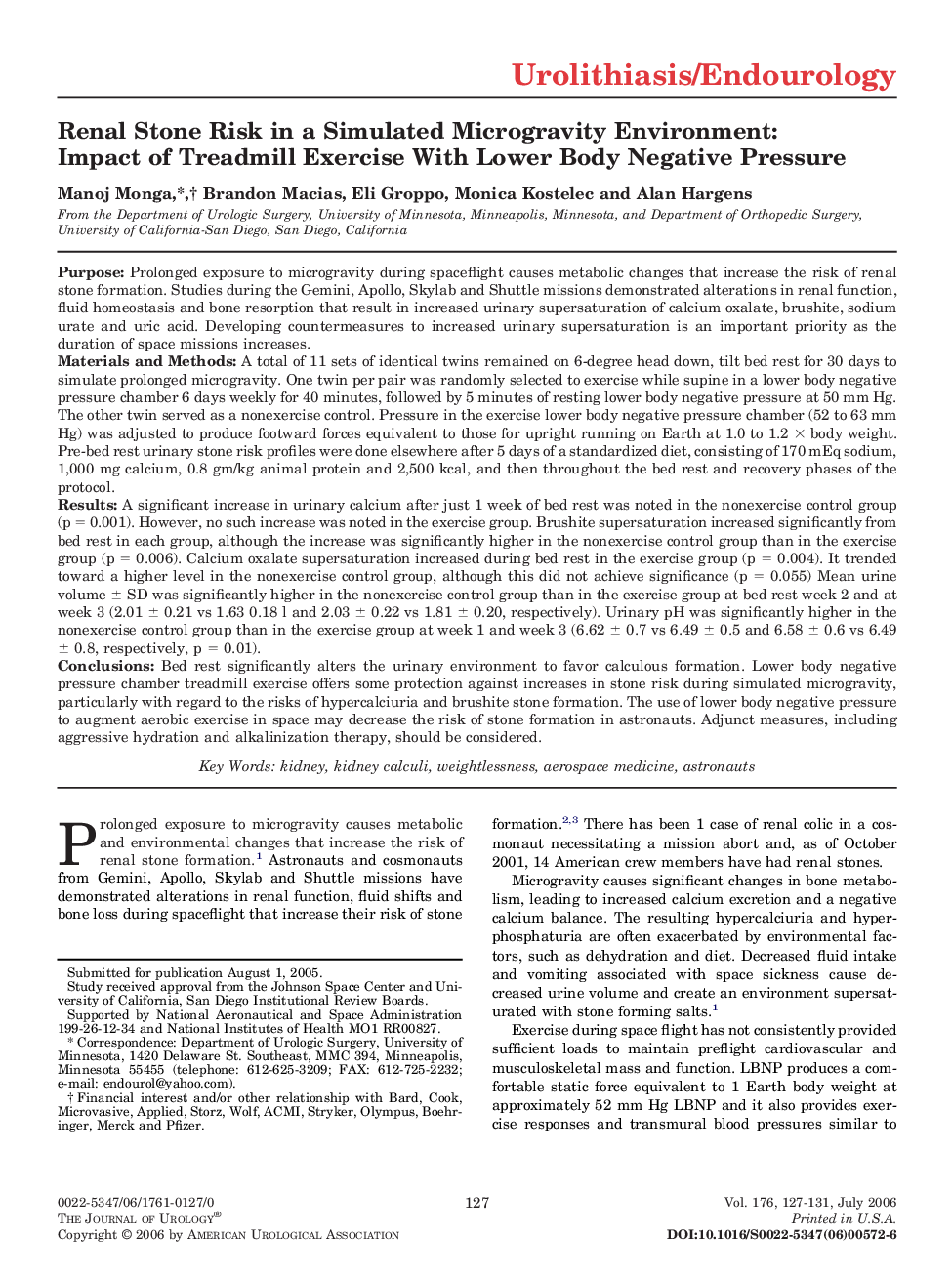| کد مقاله | کد نشریه | سال انتشار | مقاله انگلیسی | نسخه تمام متن |
|---|---|---|---|---|
| 3877164 | 1599022 | 2006 | 5 صفحه PDF | دانلود رایگان |

PurposeProlonged exposure to microgravity during spaceflight causes metabolic changes that increase the risk of renal stone formation. Studies during the Gemini, Apollo, Skylab and Shuttle missions demonstrated alterations in renal function, fluid homeostasis and bone resorption that result in increased urinary supersaturation of calcium oxalate, brushite, sodium urate and uric acid. Developing countermeasures to increased urinary supersaturation is an important priority as the duration of space missions increases.Materials and MethodsA total of 11 sets of identical twins remained on 6-degree head down, tilt bed rest for 30 days to simulate prolonged microgravity. One twin per pair was randomly selected to exercise while supine in a lower body negative pressure chamber 6 days weekly for 40 minutes, followed by 5 minutes of resting lower body negative pressure at 50 mm Hg. The other twin served as a nonexercise control. Pressure in the exercise lower body negative pressure chamber (52 to 63 mm Hg) was adjusted to produce footward forces equivalent to those for upright running on Earth at 1.0 to 1.2 × body weight. Pre-bed rest urinary stone risk profiles were done elsewhere after 5 days of a standardized diet, consisting of 170 mEq sodium, 1,000 mg calcium, 0.8 gm/kg animal protein and 2,500 kcal, and then throughout the bed rest and recovery phases of the protocol.ResultsA significant increase in urinary calcium after just 1 week of bed rest was noted in the nonexercise control group (p = 0.001). However, no such increase was noted in the exercise group. Brushite supersaturation increased significantly from bed rest in each group, although the increase was significantly higher in the nonexercise control group than in the exercise group (p = 0.006). Calcium oxalate supersaturation increased during bed rest in the exercise group (p = 0.004). It trended toward a higher level in the nonexercise control group, although this did not achieve significance (p = 0.055) Mean urine volume ± SD was significantly higher in the nonexercise control group than in the exercise group at bed rest week 2 and at week 3 (2.01 ± 0.21 vs 1.63 0.18 l and 2.03 ± 0.22 vs 1.81 ± 0.20, respectively). Urinary pH was significantly higher in the nonexercise control group than in the exercise group at week 1 and week 3 (6.62 ± 0.7 vs 6.49 ± 0.5 and 6.58 ± 0.6 vs 6.49 ± 0.8, respectively, p = 0.01).ConclusionsBed rest significantly alters the urinary environment to favor calculous formation. Lower body negative pressure chamber treadmill exercise offers some protection against increases in stone risk during simulated microgravity, particularly with regard to the risks of hypercalciuria and brushite stone formation. The use of lower body negative pressure to augment aerobic exercise in space may decrease the risk of stone formation in astronauts. Adjunct measures, including aggressive hydration and alkalinization therapy, should be considered.
Journal: The Journal of Urology - Volume 176, Issue 1, July 2006, Pages 127–131